Bostitch 216SJKB, 21697B, 21680B-ALM, 21680B, 21680-LN User Manual
...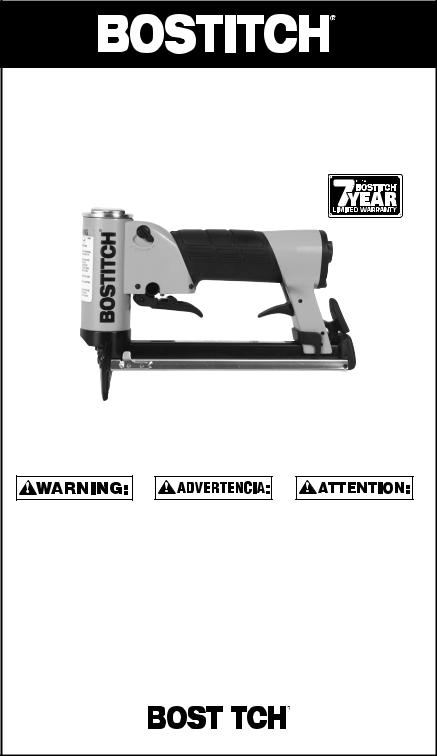
200 Series
Industrial Fine Wire Stapler Grapadora industrial de alambre fino Agrafeuse industrielle à agrafes fines
OPERATION and MAINTENANCE MANUAL MANUAL DE OPERACIÓN Y DE MANTENIMIENTO MANUEL D’INSTRUCTIONS ET D’ENTRETIEN
BEFORE OPERATING THIS TOOL, ALL OPERATORS SHOULD STUDY THIS MANUAL TO UNDERSTAND AND FOLLOW THE SAFETY WARNINGS AND INSTRUCTIONS. KEEP THESE INSTRUCTIONS WITH THE TOOL FOR FUTURE REFERENCE. IF YOU HAVE ANY QUESTIONS, CONTACT YOUR BOSTITCH REPRESENTATIVE OR DISTRIBUTOR.
ANTES DE OPERAR ESTA HERRAMIENTA, TODOS LOS OPERADORES DEBERÁN ESTUDIAR ESTE MANUAL PARA PODER COMPRENDER Y SEGUIR LAS ADVERTENCIAS SOBRE SEGURIDAD Y LAS INSTRUCCIONES. MANTENGA ESTAS INSTRUCCIONES CON LA HERRAMIENTA PARA FUTURA REFERENCIA, SI TIENE ALGUNA DUDA, COMUNÍQUESE CON SU REPRESENTANTE DE BOSTITCH O CON SU DISTRIBUIDOR.
LIRE ATTENTIVEMENT LE PRÉSENT MANUEL AVANT D’UTILISER L’APPAREIL. PRÉTER UNE ATTENTION TOUTE PARTICULIÈRE AUX CONSIGNES DE SÉCURITÉ ET AUX AVERTISSEMENTS. GARDER CE MANUEL AVEC L’OUTIL POUR FUTUR RÉFÉRENCE. SI VOUS AVEZ DES QUESTIONS, CONTACTEZ VOTRE REPRÉSENTANT OU VOTRE CONCESSIONNAIRE BOSTITCH.
|
|
|
|
174325REVB 6/07 |
STANLEY FASTENING SYSTEMS LP |
||
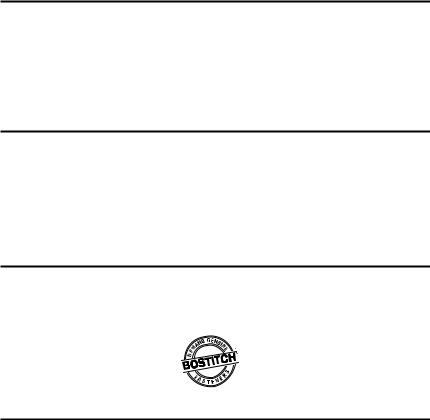
INTRODUCTION
The Bostitch upholstery tackers are precision-built tools, designed for high speed, high volume fastening. These tools will deliver efficient, dependable service when used correctly and with care. As with any fine power tool, for best performance the manufacturer's instructions must be followed. Please study this manual before operating the tool and understand the safety warnings and cautions. The instructions on installation, operation and maitenance should be read carefully, and the manual kept for reference. NOTE: Additional safety measures may be required because of your particular application of the tool. Contact your Bostitch representative or distributor with any questions concerning the tool and its use. Bostitch, Inc., East Greenwich, Rhode Island 02818.
INDEX
Safety Instructions . . . . . . . . . . . . . . . . . . . . . . . . . . . . . . . . . . . . 3
Tool Specifications . . . . . . . . . . . . . . . . . . . . . . . . . . . . . . . . . . . . 4
Air Supply and Connections . . . . . . . . . . . . . . . . . . . . . . . . . . . . . 5
Loading the Tool . . . . . . . . . . . . . . . . . . . . . . . . . . . . . . . . . . . . . . 6
Tool Operation . . . . . . . . . . . . . . . . . . . . . . . . . . . . . . . . . . . . . . . 7
Power Adjustment Valve . . . . . . . . . . . . . . . . . . . . . . . . . . . . . . . . 8
Maintaining the Pneumatic Tool . . . . . . . . . . . . . . . . . . . . . . . . . 10
Trouble Shooting . . . . . . . . . . . . . . . . . . . . . . . . . . . . . . . . . . . . . 11
NOTE :
Bostitch tools have been engineered to provide excellent customer satisfaction and are designed to achieve maximum performance when used with precision Bostitch fasteners engineered to the same exacting standards. Bostitch cannot assume responsibility for product performance if our tools are used with fasteners or accessories not meeting the specific requirements established for genuine Bostitch nails, staples and accessories.
LIMITED WARRANTY — U.S. and Canada Only
Effective December 1, 2005 Bostitch, L.P. warrants to the original retail purchaser that the product purchased is free from defects in material and workmanship, and agrees to repair or replace, at Bostitch’s option, any defective Bostitch branded pneumatic stapler or nailer for a period of seven (7) years from date of purchase (one
(1) year from the date of purchase for compressors and tools used in production applications). Warranty is not transferable. Proof of purchase date required. This warranty covers only damage resulting from defects in material or workmanship; it does not cover conditions or malfunctions resulting from normal wear, neglect, abuse, accident or repairs attempted or made by other than our national repair center or authorized warranty service centers. Driver blades, bumpers, o-rings, pistons and piston rings are considered normally wearing parts. For optimal performance of your Bostitch tool always use genuine Bostitch fasteners and replacement parts.
THIS WARRANTY IS IN LIEU OF ALL OTHER WARRANTIES, EXPRESS OR IMPLIED, INCLUDING BUT NOT LIMITED TO THE IMPLIED WARRANTIES OF MERCHANTABILITY OR FITNESS FOR A PARTICULAR PURPOSE. BOSTITCH SHALL NOT BE LIABLE FOR ANY INCIDENTAL OR CONSEQUENTIAL DAMAGES.
Some states and countries do not allow limitations on how long an implied warranty lasts, or the exclusion or limitation of incidental or consequential damages, so the above limitations or exclusions may not apply to you. This warranty gives you specific legal rights, and you may also have other rights which vary from state to state and country to country.
To obtain warranty service in the U.S. return the product, together with proof of purchase, to the U.S. Bostitch National or Regional Independent Authorized Warranty Service Center. In the U.S. you may call us at 1-800- 556-6696 or visit www.BOSTITCH.com for the location most convenient for you. In Canada please call us at 1- 800-567-7705 or visit www.BOSTITCH.com
-2-
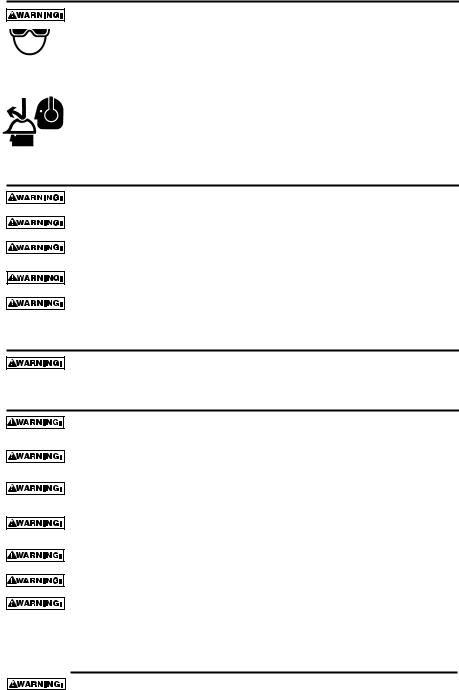
SAFETY INSTRUCTIONS
EYE PROTECTION which conforms to ANSI specifications and provides protection against flying particles both from the FRONT and SIDE should ALWAYS be worn by the operator and others in the work area when connecting to air supply, loading, operating or servicing this tool. Eye protection is required to guard against flying fasteners and debris, which could cause severe eye injury.
The employer and/or user must ensure that proper eye protection is worn. Eye protection equipment must conform to the requirements of the American National Standards Institute, ANSI Z87.1 and provide both frontal and side protection. NOTE: Non-side shielded spectacles and face shields alone do not provide adequate protection.
CAUTION: Additional Safety Protection will be required in some environments. For example, the working area may include exposure to noise level which can lead to hearing damage. The employer and user must ensure that any necessary hearing protection is provided and used by the operator and others in the work area. Some environments will require the use of head protection equipment. When required, the employer and user must ensure that head protection conforming to ANSI Z89.1 is used.
AIR SUPPLY AND CONNECTIONS
Do not use oxygen, combustible gases, or bottled gases as a power source for this tool as tool may explode, possibly causing injury.
Do not use supply sources which can potentially exceed 200 P.S.I.G. as tool may burst, possibly causing injury.
The connector on the tool must not hold pressure when air supply is disconnected. If a wrong fitting is used, the tool can remain charged with air after disconnecting and thus will be able to drive a fastener even after the air line is disconnected possibly causing injury.
Do not pull trigger or depress contact arm while connected to the air supply as the tool may cycle, possibly causing injury.
Always disconnect air supply: 1.) Before making adjustments; 2.) When servicing the tool; 3.) When clearing a jam; 4.) When tool is not in use; 5.) When moving to a different work area, as accidental actuation may occur, possibly causing injury.
LOADING TOOL
When loading tool: 1.) Never place a hand or any part of body in fastener discharge area of tool; 2.) Never point tool at anyone; 3.) Do not pull the trigger or depress the trip as accidental actuation may occur, possibly causing injury.
OPERATION
Always handle the tool with care: 1.) Never engage in horseplay; 2.) Never pull the trigger unless nose is directed toward the work; 3.) Keep others a safe distance from the tool while tool is in operation as accidental actuation may occur, possibly causing injury.
The operator must not hold the trigger pulled on contact arm tools except during fastening operation as serious injury could result if the trip accidentally contacted someone or something, causing the tool to cycle.
Keep hands and body away from the discharge area of the tool. A contact arm tool may bounce from the recoil of driving a fastener and an unwanted second fastener may be driven possibly causing injury.
Check operation of the contact arm mechanism frequently. Do not use the tool if the arm is not working correctly as accidental driving of a fastener may result. Do not interfere with the proper operation of the contact arm mechanism.
Do not drive fasteners on top of other fasteners or with the tool at an overly steep angle as this may cause deflection of fasteners which could cause injury.
Do not drive fasteners close to the edge of the work piece as the wood may split, allowing the fastener to be deflected possibly causing injury.
This nailer produces SPARKS during operation. NEVER use the nailer near flammable substances, gases or vapors including lacquer, paint, benzine, thinner, gasoline, adhesives, mastics, glues or any other material that is -- or the vapors, fumes or byproducts of which are -- flammable, combustible or explosive. Using the nailer in any such environment could cause an EXPLOSION resulting in personal injury or death to user and bystanders.
MAINTAINING THE TOOL
When working on air tools note the warnings in this manual and use extra care when evaluating problem tools.
-3-

TOOL SPECIFICATIONS
All screws and nuts are metric
MODEL |
LENGTH |
HEIGHT |
WIDTH |
WEIGHT |
21671B |
8.71" (221.25 mm) |
5.92” (150.26 mm) |
1.58” (40.2 mm) |
1.88 lb (.853 kg) |
21671B-LN |
8.71" (221.25 mm) |
7.81” (198.30 mm) |
1.58” (40.2 mm) |
2.01 lb (.912 kg) |
21671B-A |
8.71” (221.25 mm) |
5.92” (150.26 mm) |
1.58” (40.2 mm) |
1.91 lb (.867 kg) |
2161B-ALM |
13.925” (353.69 mm) |
5.92” (150.26 mm) |
1.58” (40.2 mm) |
2.37 lb (1.075 kg) |
21680B |
8.71” (221.25 mm) |
5.92” (150.26 mm) |
1.58” (40.2 mm) |
1.82 lb (.807 kg) |
21680-LN |
8.71" (221.25 mm) |
7.81” (198.30 mm) |
1.58” (40.2 mm) |
1.97 lb (.894 kg) |
21680B-ALM |
13.925” (353.69 mm) |
5.92” (150.26 mm) |
1.58” (40.2 mm) |
2.26 lb (1.025 kg) |
21684B |
8.71” (221.25 mm) |
5.92” (150.26 mm) |
1.58” (40.2 mm) |
1.82 lb (.826 kg) |
21697B |
8.71” (221.25 mm) |
5.92” (150.26 mm) |
1.58” (40.2 mm) |
1.79 lb (.813 kg) |
216SJKB |
8.71” (221.25 mm) |
5.92” (150.26 mm) |
1.58” (40.2 mm) |
1.79 lb (.813 kg) |
|
|
|
|
|
FASTENER SPECIFICATIONS
TOOL MODEL |
STAPLE SERIES |
CROWN WIDTH |
WIRE SIZE |
FASTENER RANGE |
21671B |
BA71 |
3/8” (9.0 mm) |
.023X.030(.58mmX.75mm) |
5/32"-5/8"(4mm-16mm) |
21671B-LN |
BA71 |
3/8” (9.0 mm) |
.023X.030(.58mmX.75mm) |
5/32"-5/8"(4mm-16mm) |
216-71B-A |
BA71 |
3/8” (9.0 mm) |
.023X.030(.58mmX.75mm) |
5/32"-5/8"(4mm-16mm) |
21671B-ALM |
BA71 |
3/8” (9.0 mm) |
.023X.030(.58mmX.75mm) |
5/32"-5/8"(4mm-16mm) |
21680B |
BA80 |
1/2” (13mm) |
.027X.036(.69mmX.91mm) |
5/32”-5/8”(4mm-16mm) |
21680B-LN |
BA80 |
1/2” (13mm) |
.027X.036(.69mmX.91mm) |
5/32”-5/8”(4mm-16mm) |
21680B-ALM |
BA80 |
1/2” (13mm) |
.027X.036(.69mmX.91mm) |
5/32”-5/8”(4mm-16mm) |
21684B |
SBNK, ATRO 84 |
31/64”(12.3mm) |
.023X.040(.55mmX1mm) |
5/32”-5/8”(4mm-16mm) |
21697B |
BA97 |
3/16”(4.8mm) |
.027X.036(.69mmX.91mm) |
5/32’-5/8”(4mm-16mm) |
216SJKB |
ATRO SJK |
5/32”(4.1mm) |
.024X.029(.60mmX.70mm) |
5/32”-5/8”(4mm-16mm) |
|
|
|
|
|
TOOL AIR FITTING
This tool uses a free-flow connector plug, 1/4” N.P.T. The inside diameter should be .200” (5mm) or larger. The fitting must be capable of discharging tool air pressure when disconnected from the air supply.
OPERATING PRESSURE
70 to 100 p.s.i.g. (4.8 to 6.9 bar). Select the operating pressure within this range for best fastener performance.
DO NOT EXCEED THE RECOMMENDED OPERATING PRESSURE.
AIR CONSUMPTION
The 216 requires 1.71 cubic feet per minute (.048 cubic meters) and the 216-LN models require 1.84 cubic feet per minute (.052 cubic meters) of free air to operate at the rate of 100 nails per minute, at 80 p.s.i. (5.5 bar). Take the actual rate at which the tool will be run to determine the amount of air required. For instance, if your fastener usage averages 50 nails per minute, you need 50% of the tool’s c.f.m. which is required to operate the tool at 100 nails per minute.
-4-

AIR SUPPLY AND CONNECTIONS
Do not use oxygen, combustible gases, or bottled gases as a power source for this tool as tool may explode, possibly causing injury.
Fittings:
Install a male plug on the tool which is free flowing and which will release air pressure from the tool when disconnected from the supply source.
Hoses:
Air hoses should have a minimum of 150 p.s.i. (10.34 bar) working pressure rating or 150 percent of the maximum pressure that could be produced in the air system. The supply hose should contain a fitting that will provide “quick disconnecting” from the male plug on the tool.
Supply Source:
Use only clean regulated compressed air as a power source for this tool. NEVER USE
OXYGEN, COMBUSTIBLE GASES, OR BOTTLED GASES, AS A POWER SOURCE FOR THIS TOOL AS TOOL MAY EXPLODE.
Regulator:
A pressure regulator with an operating pressure of 0 - 125 p.s.i. (0 - 8.6 bar) is required to control the operating pressure for safe operation of this tool. Do not connect this tool to air pressure which can potentially exceed 200 p.s.i. (13.8 bar) as tool may fracture or burst, possibly causing injury.
Operating Pressure:
Do not exceed recommended maximum operating pressure as tool wear will be greatly increased. The air supply must be capable of maintaining the operating pressure at the tool. Pressure drops in the air supply can reduce the tool’s driving power. Refer to “TOOL SPECIFICATIONS” for setting the correct operating pressure for the tool.
Filter:
Dirt and water in the air supply are major causes of wear in pneumatic tools. A filter will help to get the best performance and minimum wear from the tool. The filter must have adequate flow capacity for the specific installation. The filter has to be kept clean to be effective in providing clean compressed air to the tool. Consult the manufacturer’s instructions on proper maintenance of your filter. A dirty and clogged filter will cause a pressure drop which will reduce the tool’s performance.
-5-
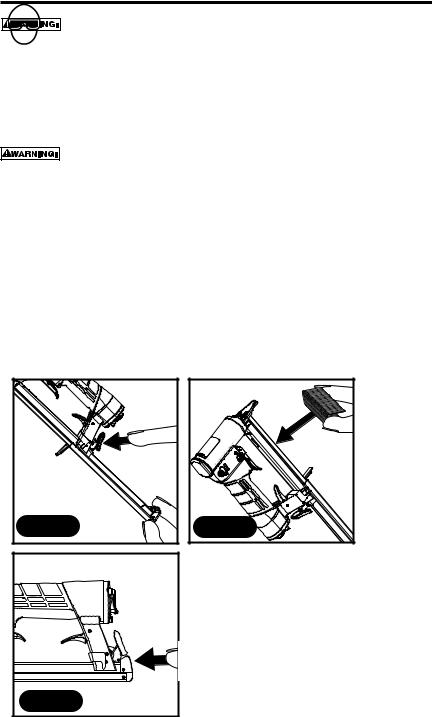
LOADING THE 216
EYE PROTECTION which conforms to ANSI specifications and provides protection against flying particles both from the FRONT and SIDE should ALWAYS be worn by the operator and others in the work area when loading, operating or servicing this tool. Eye protection is required to guard against flying fasteners and debris, which could cause severe eye injury.
The employer and/or user must ensure that proper eye protection is worn. Eye protection equipment must conform to the requirements of the American National Standards Institute, ANSI Z87.1 and provide both frontal and side protection. NOTE: Non-side shielded spectacles and face shields alone do not provide adequate protection.
TO PREVENT ACCIDENTAL INJURIES:
•Never place a hand or any other part of the body in nail discharge area of tool while the air supply is connected.
•Never point the tool at anyone else.
•Never engage in horseplay.
•Never pull the trigger unless nose is directed at the work.
•Always handle the tool with care.
•Do not pull the trigger while loading the tool.
Loading
1.Turn tool sideways with discharge area pointed away from yourself and others. Depress the quick release latch inside the tool frame or the latch on the rear of the main frame. Slide rail to rear.
2.Drop staple stick into magazine.
3.Push rail forward until the latch closes. The tool is now ready for use.
FIG 1 |
FIG 3 |
FIG 2 |
-6-
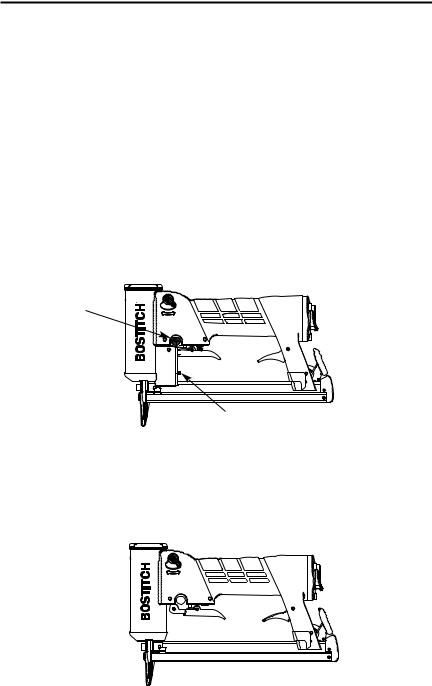
TOOL OPERATION
BEFORE HANDLING OR OPERATING THIS TOOL:
I. READ AND UNDERSTAND THE WARNINGS CONTAINED IN THIS MANUAL.
II.REFER TO “TOOL SPECIFICATIONS” IN THIS MANUAL TO IDENTIFY THE OPERATING SYSTEM ON YOUR TOOL.
BOSTITCH offers two types of Operation for the 216 series tools.
MODEL IDENTIFICATION
Refer to Tool Operation Check on page 9 before proceeding to use this tool.
Automatic:
Identified by
Speed Adjustment
Trigger Free Play Adjustment
Speed Adjustment
Trigger Free Play Adjustment
Trigger Operated:
Identified by
No Speed Adjustment
No Trigger Free Play Adjustment
-7-
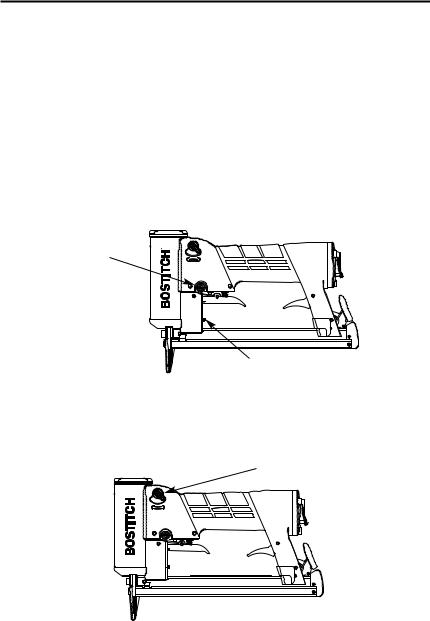
MODEL IDENTIFICATION (Continued)
Trigger Operated:
The Trigger Operated model is cycled by actuation of the trigger.
The Trigger Operated tool will cycle each time the trigger is actuated.
Automatic:
The automatic model is cycled by actuation of the trigger. When the trigger is pulled lightly with a short motion the tool will drive one fastener. When the trigger is pulled as far as possible the tool will continuously drive fasteners automatically until the trigger is released. The rate at which fasteners are driven in the automatic mode is adjustable. The speed adjustment screw is located on the left side of the tool in the trigger valve area. Turning the screw in a counter clockwise direction increases speed and in a clockwise direction decreases speed. This model also includes a trigger free play adjustment to adjust the amount of trigger stroke between single and automatic operation. Turning the adjustment knob to the left increases the trigger travel from single actuation to automatic.
Speed Adjustment
Trigger Free Play Adjustment
POWER ADJUSTMENT VALVE
Power Adjustment Knob
For Maximum Power: Rotate valve counterclockwise as far as possible. To Reduce Power: Rotate valve clockwise for up to 30% reduction.
-8-

TOOL OPERATION CHECK:
CAUTION: Remove all fasteners from tool before performing tool operation check.
1.Trigger Operated Tool:
A.With finger off the trigger, hold the tool with a firm grip on the handle.
B.Place the nose of the tool against the work surface.
C.Pull the trigger to cycle the tool. Release the trigger and cycle is complete. CAUTION: THE TOOL WILL CYCLE EACH TIME THE TRIGGER IS PULLED!
2.Automatic Tool:
A.With finger off the trigger, hold the tool with a firm grip on the handle.
B.Place the nose of the tool against the work surface.
C.Single cycle mode:
Lightly pull the trigger for a single cycle. Release the trigger and cycle is complete. CAUTION: THE TOOL WILL CYCLE EACH TIME THE TRIGGER IS PULLED!
D.Automatic mode:
Pull trigger as far as possible to depress both valve stems. Release the trigger to stop. CAUTION: THE TOOL WILL CYCLE AT UP TO 30 TIMES A SECOND IN AUTOMATIC MODE.
IN ADDITION TO THE OTHER WARNINGS CONTAINED IN THIS MANUAL
OBSERVE THE FOLLOWING FOR SAFE OPERATION
•Use the BOSTITCH pneumatic tool only for the purpose for which it was designed.
•Never use this tool in a manner that could cause a fastener to be directed toward the user or others in the work area.
•Do not use the tool as a hammer.
•Always carry the tool by the handle. Never carry the tool by the air hose.
•Do not alter or modify this tool from the original design or function without approval from BOSTITCH, INC.
•Always be aware that misuse and improper handling of this tool can cause injury to yourself and others.
•Never clamp or tape the trigger or contact trip in an actuated position.
•Never leave a tool unattended with the air hose attached.
•Do not operate this tool if it does not contain a legible WARNING LABEL.
•Do not continue to use a tool that leaks air or does not function properly. Notify your nearest Bostitch representative if your tool continues to experience functional problems.
-9-
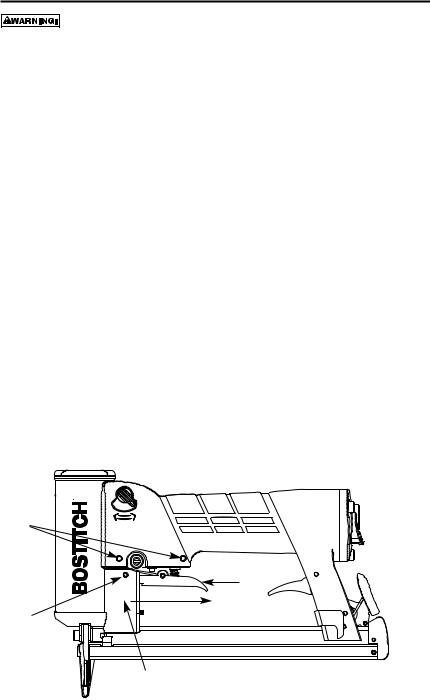
MAINTAINING THE PNEUMATIC TOOL
When working on air tools, note the warnings in this manual and use extra care evaluating problem tools.
Replacement Parts:
BOSTITCH replacement parts are recommended. Do not use modified parts or parts which will not give equivalent performance to the original equipment.
Assembly procedure for seals:
When repairing a tool, make sure the internal parts are clean and lubricated. Use MAGNALUBE or equivalent on all “O”-rings. Coat each “O”-ring with MAGNALUBE before assembling. Use a small amount of oil on all moving surfaces and pivots.
Air Supply - Pressure and Volume:
Air volume is as important as air pressure. The air volume supplied to the tool may be inadequate because of undersize fittings and hoses, or from the effects of dirt and water in the system. Restricted air flow will prevent the tool from receiving an adequate volume of air, even though the pressure reading is high. The results will be slow operation, misfeeds or reduced driving power. Before evaluating tool problems for these symptoms, trace the air supply from the tool to the supply source for restrictive connectors, swivel fittings, low points containing water and anything else that would prevent full volume flow of air to the tool.
Trigger Valve Removal:
Automatic
1.Remove trigger pivot pin.
2.Remove trigger.
3.To remove trigger free play adjustment housing pull in direction of arrow until it is clear of valve.
4.Remove two trigger valve pins and remove trigger valve.
Standard Valve
Remove two trigger valve pins (item 4) and remove trigger valve.
4 |
|
|
2 |
1 |
Pull |
|
3
-10-
